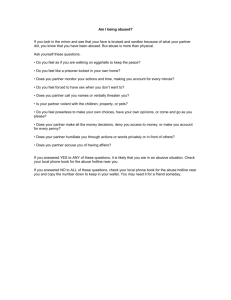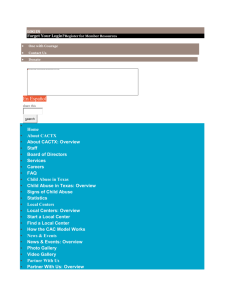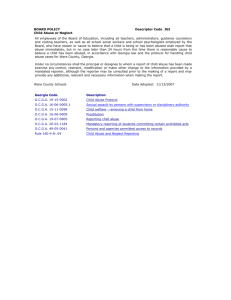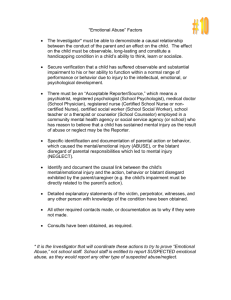child abuse in the us
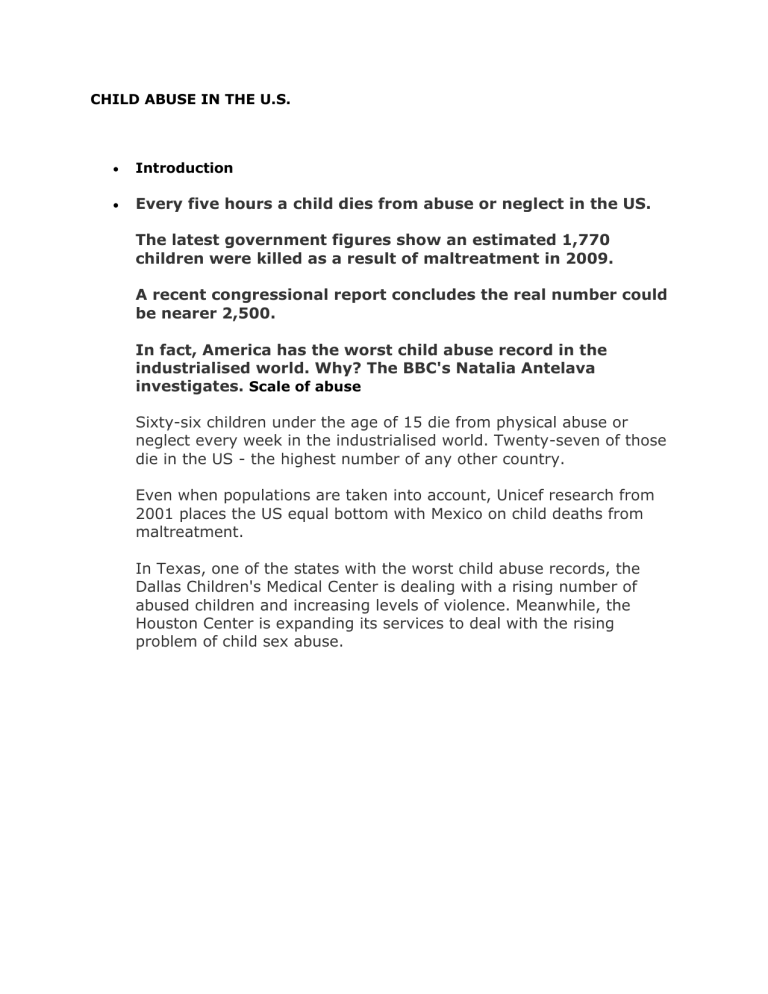
CHILD ABUSE IN THE U.S.
Introduction
Every five hours a child dies from abuse or neglect in the US.
The latest government figures show an estimated 1,770 children were killed as a result of maltreatment in 2009.
A recent congressional report concludes the real number could be nearer 2,500.
In fact, America has the worst child abuse record in the industrialised world. Why? The BBC's Natalia Antelava investigates. Scale of abuse
Sixty-six children under the age of 15 die from physical abuse or neglect every week in the industrialised world. Twenty-seven of those die in the US - the highest number of any other country.
Even when populations are taken into account, Unicef research from
2001 places the US equal bottom with Mexico on child deaths from maltreatment.
In Texas, one of the states with the worst child abuse records, the
Dallas Children's Medical Center is dealing with a rising number of abused children and increasing levels of violence. Meanwhile, the
Houston Center is expanding its services to deal with the rising problem of child sex abuse.
Who's to blame?
Just like Emma Thompson, hundreds more children fall through the cracks of the child protection system.
Some blame overworked investigators and inefficient management, while others say it's the federal government's drive to keep families together that is the problem.
But child protection officials in Texas, a state with one of the highest total number of child deaths from abuse and neglect in the US, say such cases are complicated and difficult to assess - especially when a child's guardians are hiding what is really going on.
In Washington, politicians are beginning to recognise what some now describe as a "national crisis".
A congressional hearing in July heard from experts in the field about what can be done to prevent deaths from child abuse. A national commission is being set up to coordinate a country-wide response.
Many believe home visits to new parents by qualified health professionals, preparing them for the difficulties of family life, are key to that strategy.
While child abuse blights the lives of victims' families, its devastating impact is felt far beyond relatives and friends.
Abused children are 74 times more likely to commit crimes against others and six times more likely to maltreat their own children, according to the Texas Association for the Protection of Children.
For this reason, experts believe it is in the US government's as well as society's interest to ensure children are protected from abuse. Each and every citizen, they say, has a responsibility to help break this cycle of violence.
America's child death shame
Millions of children are reported as abused and neglected every year
Why is the problem of violence against children so much more acute in the US than anywhere else in the industrialised world, asks Michael Petit, President of Every
Child Matters.
Over the past 10 years, more than 20,000 American children are believed to have been killed in their own homes by family members. That is nearly four times the number of US soldiers killed in Iraq and Afghanistan.
The child maltreatment death rate in the US is triple Canada's and 11 times that of
Italy. Millions of children are reported as abused and neglected every year. Why is that?
Downward spiral
Part of the answer is that teen pregnancy, high-school dropout, violent crime, imprisonment, and poverty - factors associated with abuse and neglect - are generally much higher in the US
The sharp differences between the states raises the question of an expanded federal role”
Every Child Matters
Further, other rich nations have social policies that provide child care, universal health insurance, pre-school, parental leave and visiting nurses to virtually all in need.
In the US, when children are born into young families not prepared to receive them, local social safety nets may be frayed, or non-existent. As a result, they are unable to compensate for the household stress the child must endure.
In the most severe situations, there is a predictable downward spiral and a child dies. Some 75% of these children are under four, while nearly half are under one.
Geography matters a lot in determining child well-being. Take the examples of
Texas and Vermont.
Texas prides itself in being a low tax, low service state. Its per capita income places it in the middle of the states, while its total tax burden - its willingness to tax itself
- is near the bottom.
Vermont, in contrast, is at the other extreme. It is a high-tax, high-service state.
Mix of risks
In looking at key indicators of well-being, children from Texas are twice as likely to drop out of high school as children from Vermont. They are four times more likely to be uninsured, four times more likely to be incarcerated, and nearly twice as likely to die from abuse and neglect.
Texas spending
$6.25 billion (£4.01bn) spent in 2007 on direct and indirect costs dealing
with after-effects of child abuse and neglect
$0.05 billion (£0.03bn) budgeted in 2011 for prevention and early intervention
Source: Univ of Houston, TexProtects
In Texas, a combination of elements add to the mix of risks that a child faces.
These include a higher poverty rate in Texas, higher proportions of minority children, lower levels of educational attainment, and a political culture which holds a narrower view of the role of government in addressing social issues.
Texas, like many other traditionally conservative states, is likely to have a weaker response to families that need help in the first place, and be less efficient in protecting children after abuse occurs.
The sharp differences between the states raises the question of an expanded federal role.
Are children Texas children first? Or are they first American children with equal opportunity and protection?
Blame parents?
A national strategy, led by our national government, needs to be developed and implemented. For a start, the Congress should adopt legislation that would create a
National Commission to End Child Abuse and Neglect Fatalities.
Nearly half the child fatalities in 2009 were children under the age of one
And no children's programmes should be on the chopping block, federal or state.
Children did not crash the US economy. It is both shortsighted economic policy and morally wrong to make them pay the price for fixing it.
But instead as the US economy lags, child poverty soars, and states cut billions in children's services, we are further straining America's already weak safety net.
Inevitably, it means more children will die. The easy answer is to blame parents and already burdened child protection workers. But easy answers don't solve complex problems.
And with millions of children injured and thousands killed, this problem is large indeed, and it deserves a large response.
Michael Petit is the president of Every Child Matters . He served as the state of
Maine's human services commissioner, and as deputy of the Child Welfare League
of America.


